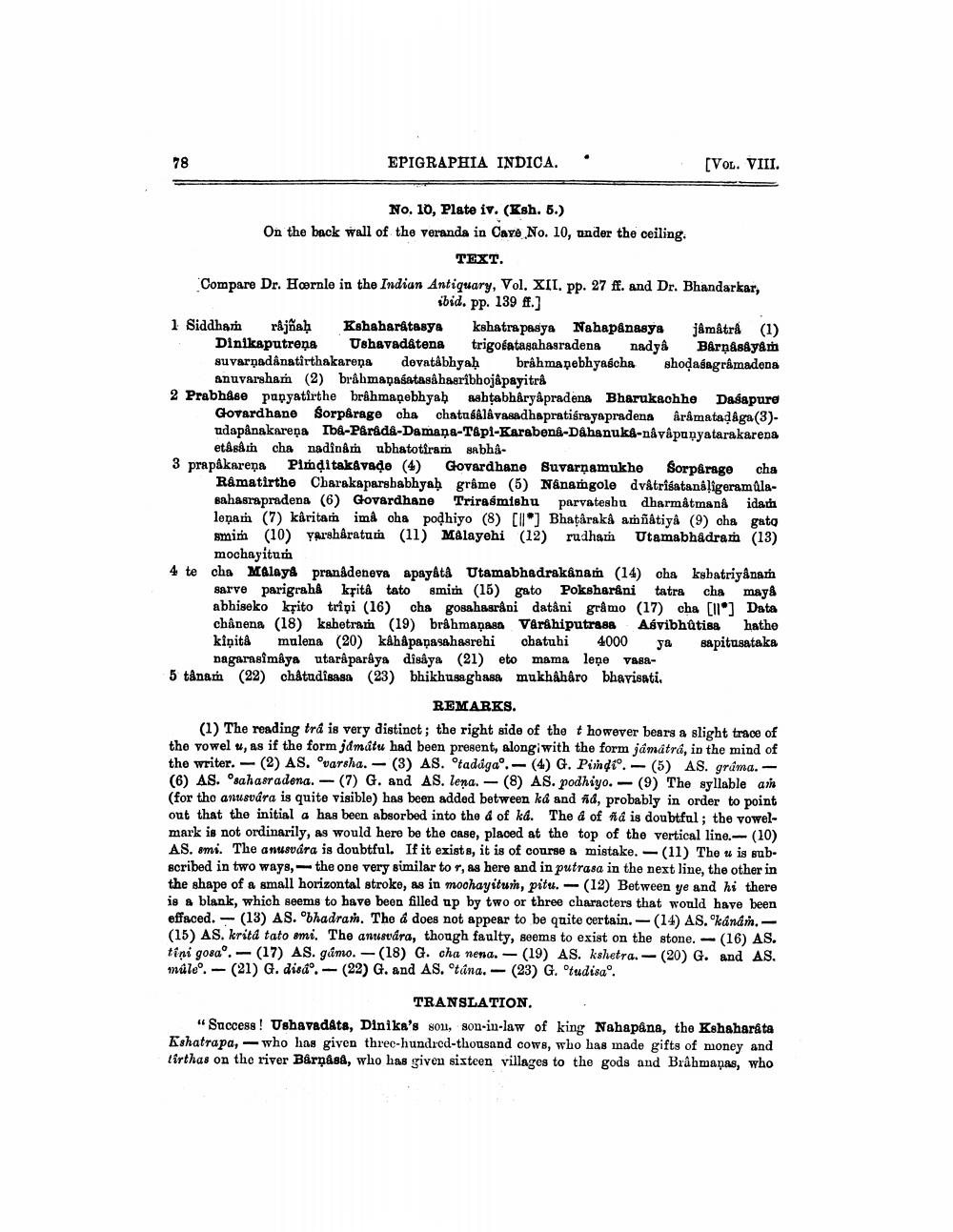________________
78
EPIGRAPHIA INDICA.
.
(VOL. VIII.
No. 10, Plate iv. (Ksh. 5.) On the back wall of the veranda in Cave No. 10, under the ceiling.
TEXT. Compare Dr. Hornle in the Indian Antiquary, Vol. XII. pp. 27 ff. and Dr. Bhandarkar,
ibid. pp. 139 ff.] 1 Siddhan rajñaḥ Kshaharátasya kshatra pasya Nahapanasya jâmâtrá (1)
Diniksputrena Ushavadátena trigobatasahasradens nadya Bårnåshyam suvarnadânatirthakarepa dovatâbhyah brahmapebhyascha shodasagrámadena
anuvargham (2) brahmanašatas&haeribboj&payitra 2 Prabhdee paṇyatirthe brahmapebhyah ashtabhâryâpradena Bharukachhe Dasapure
Govardhane Sorp&rage cha chatasalâvasadhapratigrayapradena äråmatadaga(3)udapânakareņa Iba-Parada-Damaņa-Tapi-Karabend-Dahanukd-nåvâpanyatarakarena
et&sam cha nadinám ubhatotiram sabhá3 prapäkarena Pimţitakavade (4) Govardhane Suvarnamukhe Sorpirage cha
Råmatirthe Charakaparsbabhyah grâme (5) Nânamgole dvåtrisatanáļigeramůlasahasrapradena (6) Govardhane Trirasmishu parvateshu dharmâtmanå idam leņam (7) kâritam ima oha podhiyo (8) [IS] Bhatáraká amñâtiya (9) cha gato smim (10) Yarshâratum (11) Malayehi (12) rudham Utamabhadram (13)
mochagitur 4 te cha MAlay& pranådeneva apay&ta Utamabhadrakanam (14) cha kshatriyanam
sarve parigrah kita tato smim (15) gato Poksharani tatra cha maya abhiseko krito tripi (16) cha gosahasrani datêni gråmo (17) cha [II] Data chânena (18) kshetram (19) brahmanasa Vårahiputrasa Asvibhůtisa hatho kipita molens (20) kahapanasahasrehi chatuhi 4000 ya sapitusataka
nagarasimaya utara paraya disaya (21) eto mama lepo vasa5 tånar (22) châtudisasa (23) bhikhuseghasa mukhkharo bhavisati.
REMARKS. (1) The reading trá is very distinct; the right side of the t however bears a slight trace of the vowel w, as if the form jdmatu had been present, along with the form jamátra, in the mind of the writer. - (2) AS. "varsha. - (3) AS. °tadága.-(4) G. Pindi. - (5) AS. grama. - (6) AS. sahasradona. -(7) G. and AS. lena. - (8) AS. podhiyo. - (9) The syllable ani (for the anusvára is quite visible) has been added between kå and Aid, probably in order to point out that the initial a has been absorbed into the d of ka. The d of Ad is doubtful; the vowelmark is not ordinarily, as would here be the case, placed at the top of the vertical line. - (10) AS. omi. The antsvara is doubtful. If it exists, it is of course a mistake. -(11) The u is subscribed in two ways, the one very similar to T, as here and in putrasa in the next line, the other in the shape of a small horizontal stroke, as in mochayitum, pitu. (12) Between ye and hi there is a blank, which seems to have been filled up by two or three characters that would have been effaced. - (13) AS.bhadran. The a does not appear to be quite certain. -(14) AS."kanán. - (15) AS. krità tato smi. The antsvara, though faulty, seems to exist on the stone. - (16) AS. tini gosao. - (17) AS. gamo. -(18) G. cha nena. -(19) AS. kshetra. -(20) G. and AS. múle. - (21) G. disão. - (22) G. and AS. Ctána. -(23) G. Otudisao.
TRANSLATION. "Success! UshavadAta, Dinika's sou, son-in-law of king Nahapana, the Kshaharata Kshatrapa, who has given three-hundred-thousand cows, who has made gifts of money and lirthas on the river Barnasa, who has given sisteen villages to the gods and Brahmaņas, who




